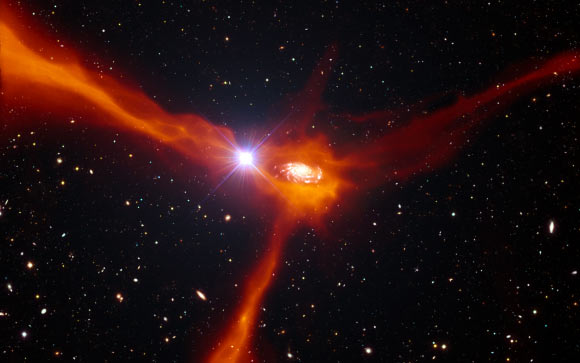Astronomers, led by Dr Nicolas Bouche from the Research Institute in Astrophysics and Planetology in Toulouse, France, have spotted a distant galaxy hungrily snacking on nearby gas.

This artist’s impression shows a galaxy in the distant Universe, just two billion years after the Big Bang, in the process of pulling in cool gas, shown in orange, from its surroundings (ESO / L. Calçada / ESA / AOES Medialab)
Scientists have always suspected that galaxies grow by pulling in material from their surroundings, but this process has proved very difficult to observe directly.
Now, they used ESO’s Very Large Telescope to observe a very rare alignment between a distant galaxy and an even more distant quasar. The light from the quasar passes through the material around the foreground galaxy before reaching Earth, making it possible to explore in detail the properties of the gas around the galaxy.
The study provides the best view so far of a galaxy in the act of feeding. It also supports the theory that galaxies pull in and devour nearby material in order to grow and form stars.
“This kind of alignment is very rare and it has allowed us to make unique observations,” said Dr Bouche, who with colleagues has reported the findings in the journal Science.
Galaxies quickly deplete their reservoirs of gas as they create new stars, and so must somehow be continuously replenished with fresh gas to keep going. Astronomers suspected that the answer to this problem lay in the collection of cool gas from the surroundings by the gravitational pull of the galaxy
The observations reveal how the galaxy itself was rotating, and also the composition and motion of the gas outside the galaxy.
“The properties of this vast volume of surrounding gas were exactly what we would expect to find if the cold gas was being pulled in by the galaxy,” said co-author Dr Michael Murphy from the Swinburne University of Technology in Melbourne, Australia.
“The gas is moving as expected, there is about the expected amount and it also has the right composition to fit the models perfectly. It’s like feeding time for lions at the zoo – this particular galaxy has a voracious appetite, and we’ve discovered how it feeds itself to grow so quickly.”
Astronomers have already found evidence of material around galaxies in the early Universe, but this is the first time that they have been able to show clearly that the material is moving inwards rather than outwards, and also to determine the composition of this fresh fuel for future generations of stars. Without the quasar’s light to act as a probe this surrounding gas would be undetectable.
“It is impressive to see in the data the telltale signatures of this infalling gas matching those expected in numerical simulations,” Dr Bouche said.
“In this case we were lucky that the quasar happened to be in just the right place for its light to pass through the infalling gas. The next generation of extremely large telescopes will enable studies with multiple sightlines per galaxy and provide a much more complete view,” said study co-author Dr Crystal Martin from the University of California Santa Barbara.
______
Bibliographic information: Bouché N. et al. 2013. Signatures of Cool Gas Fueling a Star-Forming Galaxy at Redshift 2.3. Science, vol. 341, no. 6141, pp. 50-53; doi: 10.1126/science.1234209







